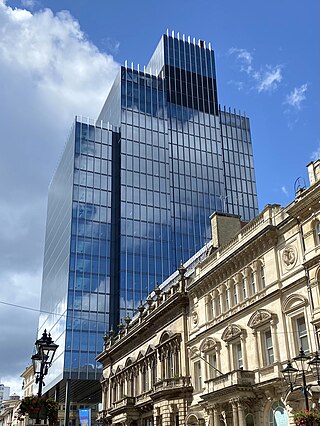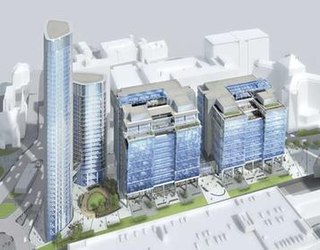
West Midlands is a metropolitan and ceremonial county in the larger West Midlands region of England. A landlocked county, it is bordered by Staffordshire to the north and west, Worcestershire to the south, and is surrounded by Warwickshire to the east. The largest settlement is the city of Birmingham.

The BT Tower is a grade II listed communications tower in Fitzrovia, London, England, owned by BT Group. It was also known as the GPO Tower and the Post Office Tower, and later officially renamed the Telecom Tower. The main structure is 581 feet (177 m) high, with a further section of aerial rigging bringing the total height to 620 feet (189 m).

The West Midlands is one of nine official regions of England at the first level of International Territorial Level for statistical purposes. It covers the western half of the area known traditionally as the Midlands. The region consists of the counties of Herefordshire, Shropshire, Staffordshire, Warwickshire, West Midlands and Worcestershire. The region has seven cities: Birmingham, Coventry, Hereford, Lichfield, Stoke-on-Trent, Wolverhampton and Worcester.

Brindleyplace is a large mixed-use canalside development, in the Westside district of Birmingham, England. It was named after Brindley Place, the name of the street around which it is built. It was developed by the Argent Group from 1993 onwards.

The Rotunda is a cylindrical highrise building in Birmingham, England. The Grade II listed building is 81 metres (266 ft) tall and was completed in 1965. Originally designed to be an office block, by architect James A. Roberts ARIBA, it was refurbished between 2004 and 2008 by Urban Splash with Glenn Howells who turned it into a residential building, with serviced apartments on 19th and 20th floors. The building was officially reopened on 13 May 2008.

Mailbox Birmingham is a mixed-use development located within the city centre of Birmingham, England. It houses British luxury department store chain Harvey Nichols, and the BBC Birmingham studios.

Lister Mills was the largest silk factory in the world. It is located in the Manningham district of Bradford, West Yorkshire, England and was built by Samuel Cunliffe Lister to replace the original Manningham Mills which had been destroyed by fire in 1871. The mill is a Grade II* listed building, built in the Italianate style of Victorian architecture.
Birmingham is one of England's principal industrial centres and has a history of industrial and scientific innovation. It was once known as 'city of a thousand trades' and in 1791, Arthur Young described Birmingham as "the first manufacturing town in the world". Right up until the mid-19th century Birmingham was regarded as the prime industrial urban town in Britain and perhaps the world, the town's rivals were more specific in their trade bases. Mills and foundries across the world were helped along by the advances in steam power and engineering that were taking place in the city. The town offered a vast array of industries and was the world's leading manufacturer of metal ware, although this was by no means the only trade flourishing in the town.

The Big City Plan is a major development plan for the city centre of Birmingham, England.

103 Colmore Row is a 108-metre tall, 26-storey commercial office building located on Colmore Row, Birmingham, England. Completed in 2021, this building replaced the former NatWest Tower designed by John Madin and completed in 1975. In 2008, a plan by then owners British Land to demolish Natwest Tower and replace it with a taller modern equivalent was approved. This plan never progressed and in 2015 the building passed to the developer Sterling Property Ventures, who successfully applied to have the building demolished. Construction of the new tower began in June 2019 and completed in 2021.

The Jewellery Quarter is an area of central Birmingham, England, in the north-western area of Birmingham City Centre, with a population of 19,000 in a 1.07-square-kilometre (264-acre) area.

Dunlop Tyres is a brand of tyres which is managed by different companies around the world. It was founded by pneumatic tyre pioneer John Boyd Dunlop in Belfast, Ireland, in 1888.

The Hoover Building is a Grade II* listed building of Art Deco architecture designed by Wallis, Gilbert and Partners located in Perivale in the London Borough of Ealing. The site opened in 1933 as the UK headquarters, manufacturing plant and repairs centre for The Hoover Company. The building is now owned by IDM Properties and has been converted into apartments.
Urban Splash is a UK-based property development business. It was founded in 1993 by chairman Tom Bloxham and creative director Jonathan Falkingham. Headquartered in Castlefield, Manchester, it also has regional bases in Liverpool, Leeds, Bristol, Sheffield, Cambridgeshire and Plymouth.

Michelin House at 81 Fulham Road, Chelsea, London, was constructed as the first permanent UK headquarters and tyre depot for the Michelin Tyre Company Ltd. The building opened for business on 20 January 1911. In 1987 the building was converted to mixed-use, with a store, restaurant, bar and office space.

The Cube is a 24-storey mixed-use development in the centre of Birmingham, England. Designed by Ken Shuttleworth of Make Architects, it contains 244 flats, 111,500 square feet (10,359 m2) of offices, shops, a hotel and a 'skyline' restaurant. It is the final phase of The Mailbox development.

Snowhill is a mixed-use development in the Colmore business district, known historically as Snow Hill, in Central Birmingham, England. The area, between Snow Hill Queensway and Birmingham Snow Hill station, is being redeveloped by the Ballymore Group. The £500 million phased scheme has been partly completed on the site of a former surface car park adjacent to the railway station and West Midlands Metro terminus.
Dunlop Ltd. was a British multinational company involved in the manufacture of various natural rubber goods. Its business was founded in 1889 by Harvey du Cros and he involved John Boyd Dunlop who had re-invented and developed the first pneumatic tyre: he invented the first practical pneumatic tyres for his child's tricycle. It was one of the first multinationals, and under du Cros and, after him, under Eric Geddes, grew to be one of the largest British industrial companies. J. B. Dunlop had dropped any ties to it well before his name was used for any part of the business. The business and manufactory was founded in Upper Stephen Street, Dublin. A plaque marks the site, which is now part of the head office of the Irish multinational departments store brand, Dunnes Stores.
Dunlop Aircraft Tyres is a company based in Birmingham, England, that designs, manufacures and retreads aircraft tyres.
Sahaganj is a neighbourhood in Bansberia of Hooghly district in the Indian state of West Bengal. It is a part of the area covered by Kolkata Metropolitan Development Authority (KMDA).

















